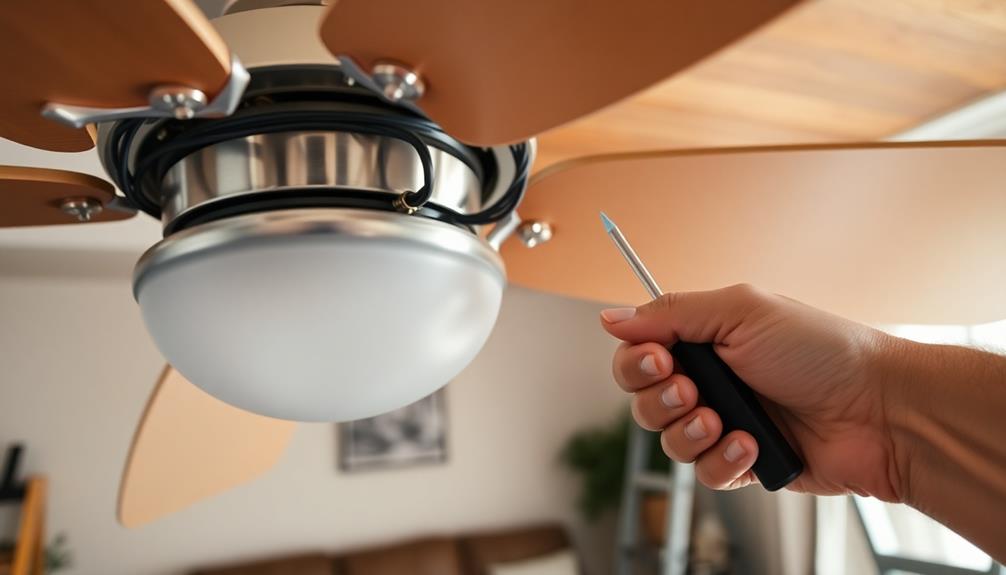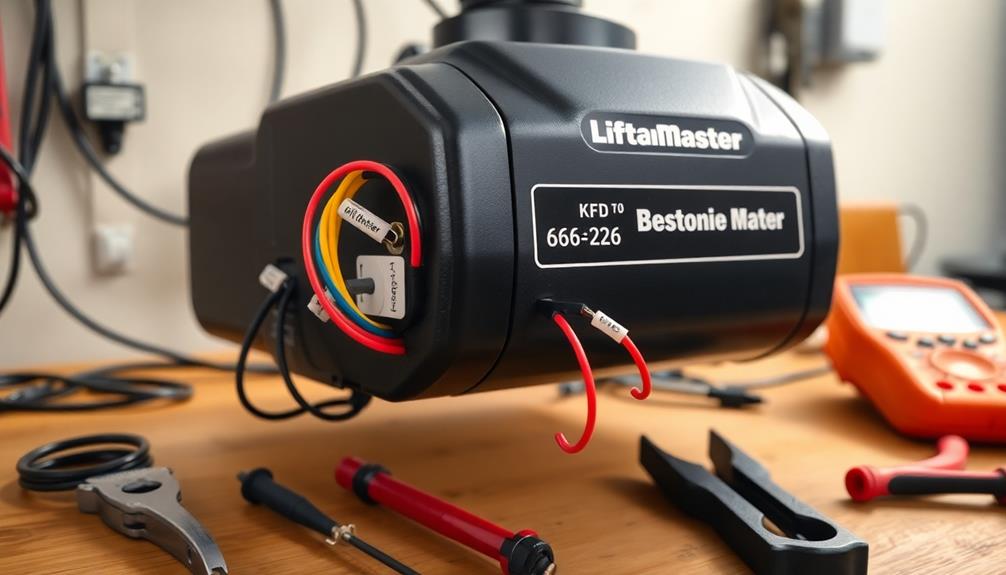To rev up your ceiling fan, start by checking the speed settings; make certain it's not set to low when you need more airflow. Regularly clean the blades and housing to prevent dust buildup that can slow it down. Inspect the motor and wiring for any loose connections while confirming it's properly installed with enough clearance. If you're using a remote, check the batteries and verify there's no interference. Address these common issues, and you'll enjoy a cool atmosphere. There's plenty more to learn about keeping your ceiling fan in top shape. Additionally, don’t forget to check the ceiling fan rotation direction, as it plays a crucial role in airflow efficiency. For optimal cooling in the summer, the blades should spin counterclockwise to push air downward, while a clockwise rotation is better for distributing warm air in the winter. A simple adjustment can make a significant difference in comfort and energy efficiency.
Key Takeaways
- Check and adjust the fan speed settings to ensure it's not set to low when higher airflow is needed.
- Regularly clean the blades and housing to eliminate dust and debris that can hinder performance.
- Inspect the motor and capacitor for functionality; consider replacing faulty components to restore speed.
- Ensure all electrical connections are secure and verify proper installation for optimal airflow.
- Test remote controls and replace batteries as needed to eliminate control issues affecting fan operation.
Causes of Slow Ceiling Fans
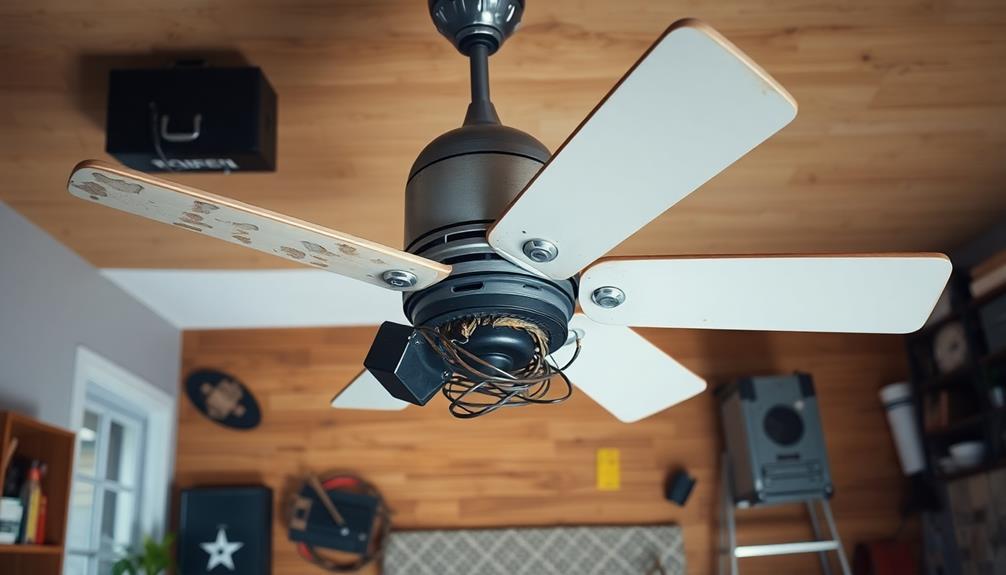
When your ceiling fan starts to slow down, it can be frustrating, especially during hot summer months. One common cause might be incorrect fan settings; you could accidentally select a lower speed when you need more airflow.
Increased fan efficiency can also play a role in ensuring your fan operates at ideal levels, so it's crucial to choose the right settings.
Dust and debris buildup on the blades can also hinder performance, making it necessary to clean them regularly. A faulty motor or capacitor may lead to speed issues, requiring inspection and possible replacement.
Additionally, improper installation or mounting can affect power delivery to the fan. Make sure all electrical connections are secure and the fan has enough clearance for ideal airflow.
Identifying these issues early can help you maintain a cool and comfortable environment.
Understanding Fan Mechanics
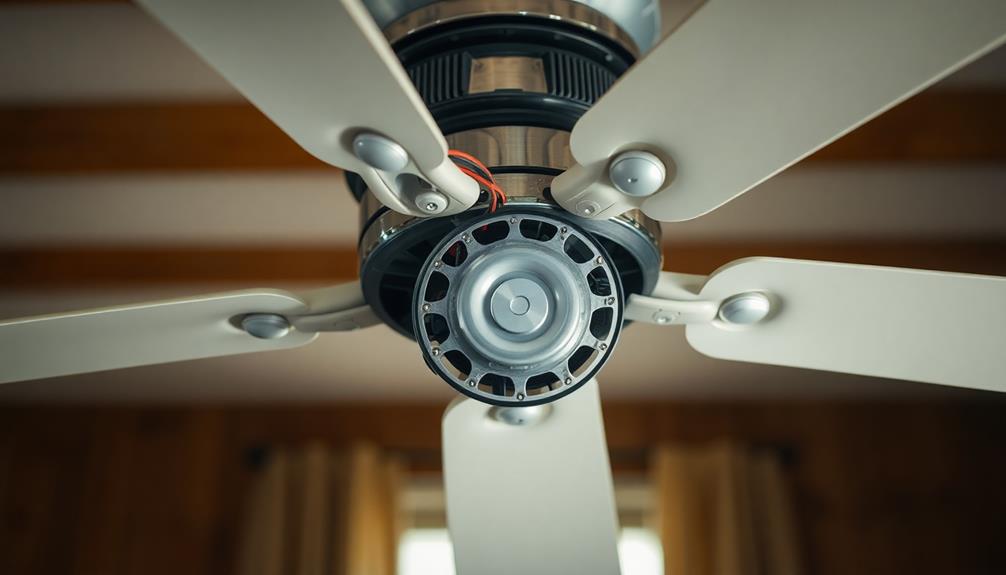
Ceiling fan mechanics are essential to understanding how your fan operates efficiently. The speed of your fan is influenced by factors like blade size, shape, and mounting angle. Larger blades generally move more air, while the angle affects airflow dynamics.
If you notice your fan slowing down, it might be due to extended use at maximum speed or improper settings. Familiarize yourself with the controls to avoid operating at low speeds unintentionally. Additionally, verify that the fan is properly installed, as loose connections or inadequate clearance can hinder performance.
By grasping these mechanics, you can troubleshoot issues effectively and optimize your ceiling fan's airflow, confirming that it operates at its best. Proper maintenance, similar to heat pump care, can also enhance the longevity and efficiency of your ceiling fan.
Regular checks for dust buildup and verifying electrical connections are secure will keep your fan in peak condition.
Maintenance Tips for Ceiling Fans
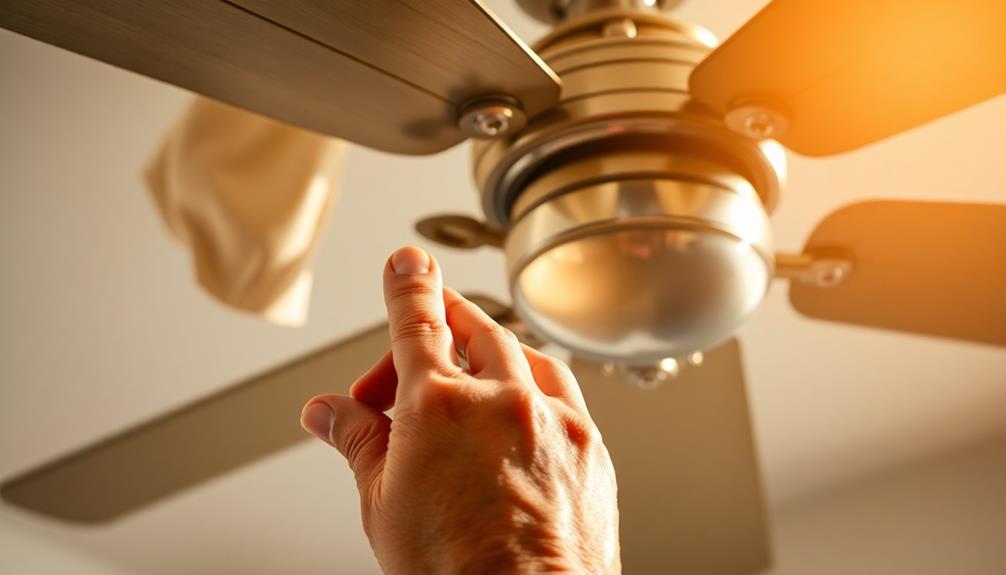
Understanding the mechanics of your ceiling fan sets the stage for effective maintenance.
To keep your fan running smoothly, regularly dust and clean the blades to prevent dirt buildup, which can reduce efficiency. Astrology claims to influence personality traits and attractiveness as a reminder of the importance of creating a comfortable and appealing environment.
Turn off the fan before cleaning and use a soft cloth or feather duster. Check the wiring and electrical connections periodically; loose connections can lead to performance issues.
If your fan has a remote control, test it frequently and replace batteries as needed. Verify that the fan is securely mounted and that there's sufficient clearance for maximum airflow.
Troubleshooting Common Issues
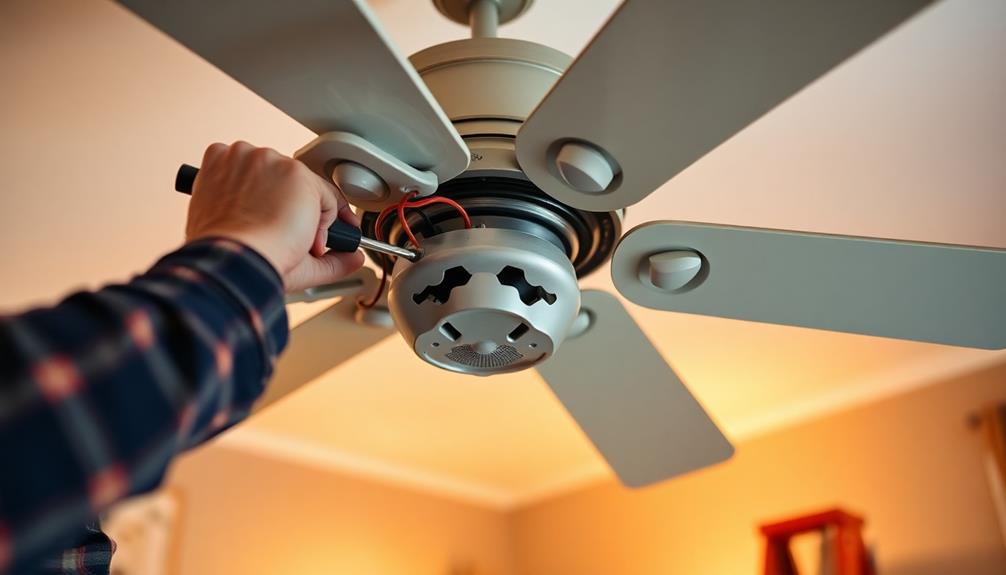
Numerous issues can arise with ceiling fans, but troubleshooting them doesn't have to be intimidating.
Here are some common problems you might encounter and how to address them:
- Incorrect Fan Settings: Check the speed settings and verify you're not on low when you need higher airflow.
- Dust and Debris Buildup: Regularly clean the blades and housing to maintain efficiency.
- Faulty Motor or Capacitor: If your fan struggles to spin, inspect the motor and consider replacing a faulty capacitor.
- Improper Installation or Mounting: Confirm all electrical connections are secure, and the fan is mounted correctly for peak airflow.
Remote Control Problems

When troubleshooting common ceiling fan issues, remote control problems can often lead to frustration. If your fan isn't responding, check the batteries in the remote first. Weak batteries can prevent signals from reaching the fan.
Next, verify there's no interference from other devices; sometimes, signals can overlap. If the fan still doesn't respond, inspect the remote for any visible damage. A stuck button could also be the culprit.
Reprogramming the remote by following the manufacturer's guidelines can help reset any glitches. If these steps don't work, the issue might be a faulty remote or receiver, requiring replacement.
Don't hesitate to consult a professional if problems persist, confirming your fan operates smoothly again.
Wall Switch Malfunctions

Wall switch malfunctions can greatly affect your ceiling fan's performance, leading to frustrating speed issues or complete inoperability.
If your fan isn't responding as expected, it might be time to troubleshoot the wall switch. Here are some common areas to check:
- Faulty Wiring: Inspect the wiring for any loose connections or damage that could disrupt power flow.
- Defective Switch: Sometimes, the switch itself fails, requiring replacement to restore functionality.
- Incompatible Switch: Verify the switch is compatible with your fan model; some fans need specific types.
- Voltage Issues: Check if the circuit provides the correct voltage; fluctuations can cause operational problems.
Address these issues promptly to keep your ceiling fan running smoothly.
Cleaning and Care Practices
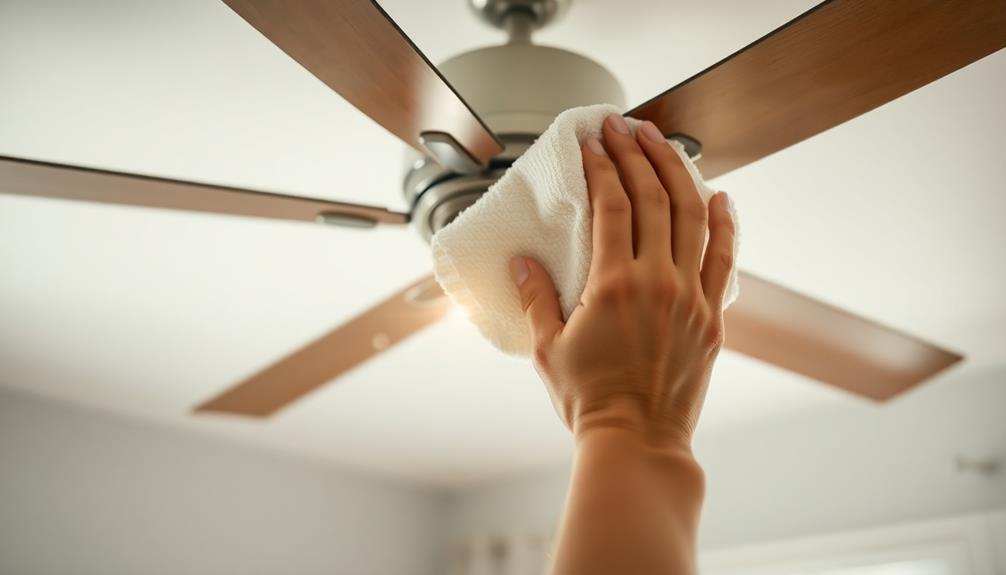
Regular cleaning and care practices are essential for keeping your ceiling fan operating efficiently and extending its lifespan. Start by dusting the blades and housing at least once a month to prevent buildup that can hinder performance. Use a soft cloth or a feather duster to gently wipe the surfaces, and for stubborn grime, a mild soap solution works wonders.
| Task | Frequency | Tools Needed |
|---|---|---|
| Dusting Blades | Monthly | Soft cloth, feather duster |
| Cleaning Housing | Monthly | Vacuum, damp cloth |
| Inspect Wiring | Every 6 Months | Screwdriver, flashlight |
When to Seek Professional Help
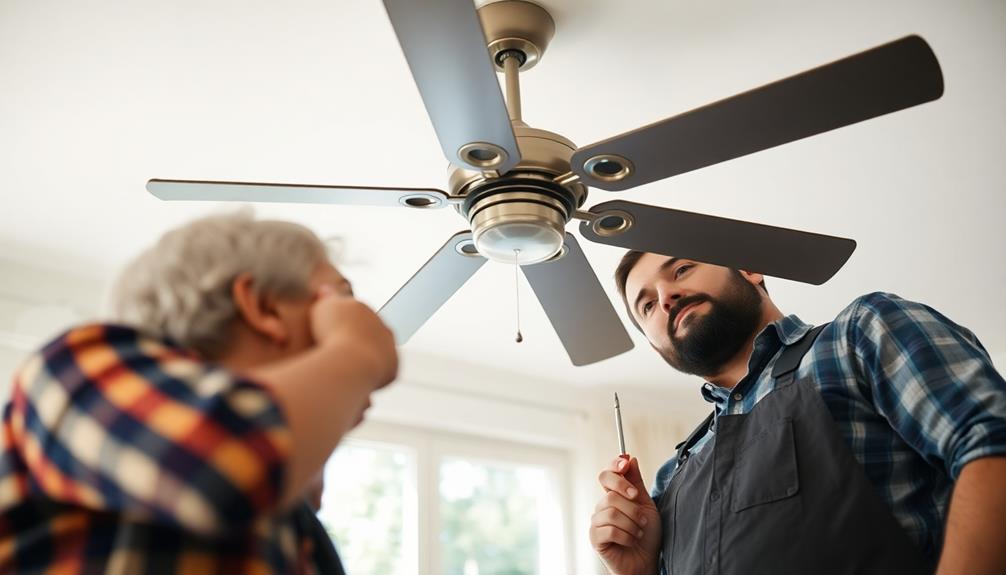
Sometimes, it's best to leave ceiling fan repairs to the professionals, especially when you encounter issues beyond basic maintenance.
If you're facing persistent problems, don't hesitate to seek help. Here are some signs that indicate it's time for a pro:
- Frequent Breakdowns: If your fan keeps breaking down even after attempts to fix it, a professional diagnosis is vital.
- Electrical Issues: Any flickering lights or unusual noises could signal wiring problems that require expert attention.
- Motor or Capacitor Failure: If you suspect a faulty motor or capacitor, it's safer to consult a technician for repairs or replacements.
- Complex Installations: For intricate setups or replacements, professional installation guarantees safety and proper functionality.
Taking these steps keeps your ceiling fan running smoothly!
Frequently Asked Questions
Can Ceiling Fans Operate Efficiently in Winter Months?
Yes, ceiling fans can operate efficiently in winter months. When set to reverse, they circulate warm air, helping maintain a comfortable temperature. Just remember to adjust the speed to suit your heating needs.
What Are the Benefits of Using a Ceiling Fan Year-Round?
Using a ceiling fan year-round is like having a personal breeze machine! You'll save on energy costs, enhance comfort, and improve air circulation. It's a simple way to create a pleasant atmosphere in any season.
How Do I Choose the Right Ceiling Fan Size for My Room?
To choose the right ceiling fan size for your room, measure the room dimensions. For smaller spaces, a fan with a 36-inch diameter works well, while larger rooms may need fans between 52 to 60 inches.
Are There Energy-Efficient Ceiling Fan Options Available?
Did you know energy-efficient ceiling fans can reduce energy costs by up to 30%? When choosing one, look for models with the Energy Star label, ensuring ideal airflow while keeping your energy consumption low.
Can I Install a Ceiling Fan on a Sloped Ceiling?
Yes, you can install a ceiling fan on a sloped ceiling. Just make certain you use a sloped ceiling mounting kit for proper alignment and stability. This'll help maintain ideal airflow and fan performance.
Conclusion
By addressing the common issues that slow down your ceiling fan, you can breathe new life into your space and enjoy a revitalizing breeze once again. Just like a well-tuned engine, a little maintenance goes a long way. So, don't let dust and neglect weigh your fan down—take the reins and implement these fixes. Your comfort is worth it, and soon enough, you'll be basking in that cool, invigorating airflow you've been missing.
